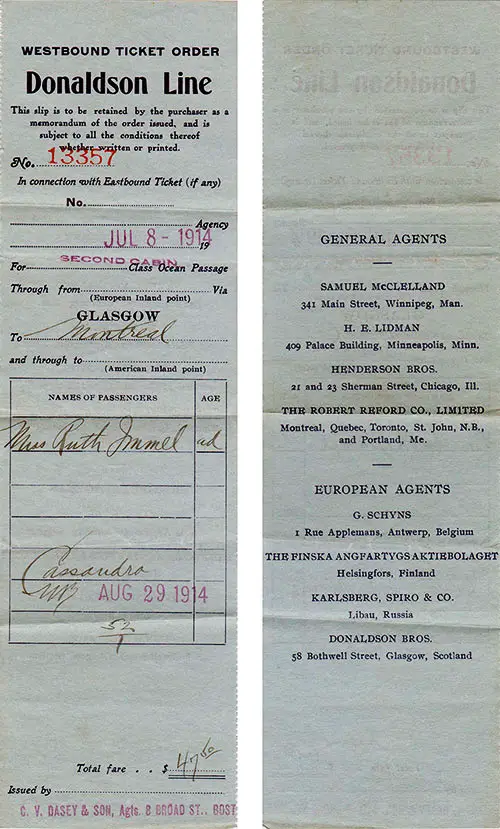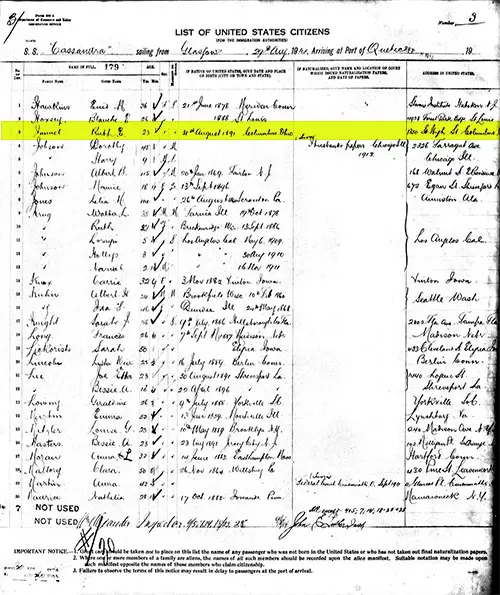SS Cassandra Passage Ticket (1914) – A Transatlantic Journey Amidst War
📌 "Discover the 1914 SS Cassandra passage ticket of American traveler Ruth Immel, documenting her second-class voyage from Glasgow to Montreal as World War I erupted. This rare historical document offers insights into pre-war ocean travel, border crossings, and the cost of transatlantic passage. Ideal for genealogists, historians, and educators."🚢

Westbound Second Cabin Ticket Order Dated 8 July 1914 , Issued by C. V. Dasey & Son, Boston for passage on the SS Cassandra of the Donaldson Line. Passenger Miss Ruth Immel, Departed from Glasgow to Montreal on 29 August 1914. | GGA Image ID # 1fa50c8c99
Summary of Agent's Record
- Date of Purchase / Voyage: 8 July 1914 / 29 August 1914
- Steamship Line: Donaldson Line
- Steamship: SS Cassandra
- Route: Glasgow to Montreal
- Ticket Type: Agent's Record
- Voyage Class: Second Cabin
- Name on Contract: Miss Ruth Immel
- Etnicity of Passenger(s): American
- Contract Terms: Not Stated
- Cost of Ticket: $47.60 / $1,270.00 USD in 2020
- Notes: A Passenger List is also availble for this voyage. See Donaldson Line Westbound Voyage for the SS Cassandra 1914-08-29
Agent's Record Details
Westbound Ticket Order
Donaldson Line
This slip is to retained by the purchaser as a memorandum of the order issued, and is subject to all the conditions thereof whether written or printed.
No. 13357
July 8 - 1914
For Second Cabin Ocean Passage
Glasgow to Montreal
Names of Passengers
Miss Ruth Immel (Adult)
Cassandra
Aug 29 1914
52/1
Total Fare $47.60
Issued by C. V. Dasey & Son, Agts. 8 Broad St., Boston
-- Reverse Side --
General Agents
Samuel McClelland
341 Main Street, Winnipeg, Manatoba
H. E. Lidman
409 Palace Buiding, Minneapolis, Minnesota
Henderson Bros.
21 and 23 Sherman Street, Chicago, Illinois
The Robert Reford Co., Limited
Montreal, Quebec, Toronto, St. John, NB and Portland, ME
European Agents
G. Schyns
1 Rue Applemans, Antwerp, Belgium
The Finska Angfartvgs Aktieboaget, Helsingfors, Finland
Karlsberg, Spiro & Co.
Libau, Russia
Donaldson Bros.
58 Bothwell Street, Glasgow, Scotland
Border Crossings from Canada to the United States

List of US Citizens Crossing Border from Canada to the United States, Arriving in Quebec on the SS Cassandra, 8 September 1914, p. 3. | GGA Image ID # 1a1ec98935
Name: Ruth E Immel Gender: Female Age: 23 Record Type: Manifests Birth Date: 31 Aug 1891 Birth Place: Ohio Birth Country: USA Port of Departure: Glasgow Arrival Date: 8 Sep 1914 Port of Arrival: Quebec, Canada Ship Name: Cassandra Line Number: 3
Source Citation
The National Archives at Washington, D.C.; Washington, D.C.; Manifests of Passengers Arriving at St. Albans, VT, District through Canadian Pacific and Atlantic Ports, 1895-1954; Record Group Title: Records of the Immigration and Naturalization Service, 1787 - 2004; Record Group Number: 85; Series Number: M1464; Roll Number: 266
Original data:
Records of the Immigration and Naturalization Service, RG 85. Washington, D.C.: National Archives and Records Administration.
Description
This database contains an index of aliens and citizens crossing into the U.S. from Canada via various ports of entry along the U.S.-Canadian border between 1895 and 1960. The records contain information on name, age, birth date, birthplace, gender, ethnicity/nationality, names of individuals accompanied by, name of nearest relative or friend in former country, and name of nearest relative or friend at destination.
Relative Cost of Passage Ticket in Today's Currency Value
In 2020, the relative values of $47.60 from 1914 ranges from $923.00 to $27,000.00.
A simple Purchasing Power Calculator would say the relative value is $1,270.00. This answer is obtained by multiplying $47.60 by the percentage increase in the CPI from 1914 to 2020.
This may not be the best answer.
The best measure of the relative value over time depends on if you are interested in comparing the cost or value of a Commodity, Income or Wealth, or a Project.
If you want to compare the value of a $47.60 Commodity in 1914 there are four choices. In 2020 the relative:
- real price of that commodity is $1,270.00
- real value in consumption of that commodity is $2,600.00
- labor value of that commodity is $6,220.00 (using the unskilled wage) or $7,780.00 (using production worker compensation)
- income value of that commodity is $8,110.00
- economic share of that commodity is $27,000.00
If you want to compare the value of a $47.60 Income or Wealth, in 1914 there are five choices. In 2020 the relative:
- real wage or real wealth value of that income or wealth is $1,270.00
- household purchasing power value of that income or wealth is $2,600.00
- relative labor earnings of that commodity are $6,220.00 (using the unskilled wage) or $7,780.00 (using production worker compensation)
- relative income value of that income or wealth is $8,110.00
- relative output value of that income or wealth is $27,000.00
If you want to compare the value of a $47.60 Project in 1914 there are four choices. In 2020 the relative:
- real cost of that project is $923.00
- household cost of that project is $2,600.00
- labor cost of that project is $6,220.00 (using the unskilled wage) or $7,780.00 (using production worker compensation)
- relative cost of that project is $8,110.00
- economy cost of that project is $27,000.00
Source: www.measuringworth.com Samuel H. Williamson, "Seven Ways to Compute the Relative Value of a U.S. Dollar Amount, 1790 to present," MeasuringWorth, 2022.
Per Canadian Department of Commerce and Labor, Immigration Service, Ruth E. Immel appeared on P. 179 of the Mannifest from the SS Cassandra, Sailing from Glasgow 29 August 1914, Arriving at the Port of Quebec 8 September 1914. Miss Immel was born 31 August 1891 in Columbus, Ohio. Her residence was 1350 So. High St., Columbus, OH.
🛳️ Recap & Summary: SS Cassandra Westbound Ticket Order - 8 July 1914
The SS Cassandra Westbound Ticket Order from 8 July 1914 offers a rare and fascinating look into transatlantic travel just weeks before the outbreak of World War I. This document, issued to Miss Ruth Immel, records her second-class voyage from Glasgow, Scotland, to Montreal, Canada, departing on 29 August 1914 aboard the Donaldson Line’s SS Cassandra.
For genealogists, historians, and educators, this passage order is a valuable primary source, illustrating the migration of American travelers returning home from Europe as war loomed over the continent. It also provides critical insights into ticketing systems, travel costs, and the infrastructure supporting ocean voyages in the early 20th century.
🌍 Why This Document Matters
🧭 Relevance to Ocean Travel & Historical Migration
A Unique Perspective on Pre-WWI Transatlantic Travel ⏳🚢
🔹 The departure date of 29 August 1914 is significant—World War I had just begun, and the outbreak of hostilities disrupted many travel plans.
🔹 While most immigration studies focus on Europeans moving westward to America, Ruth Immel’s ticket order reflects a reverse migration—an American returning from Europe.
🔹 This is an excellent resource for understanding how war impacted civilian ocean travel.
A Detailed Look at Ticketing & Agent Networks 🎫💼
🔹 The ticket was issued by C.V. Dasey & Son, a Boston-based agent, revealing the role of ticketing agencies in managing transatlantic voyages.
🔹 The reverse side lists major travel agents across North America and Europe, including Montreal, Chicago, Finland, Belgium, and Russia, demonstrating the extensive reach of the Donaldson Line and its partners.
🔹 Understanding these ticketing networks is crucial for genealogists tracing ancestors’ immigration and travel routes.
Canada as a Major Entry Point for U.S.-Bound Travelers 🇨🇦➡️🇺🇸
🔹 Instead of arriving directly in the United States, Ruth Immel entered North America via Quebec, Canada, before crossing the border.
🔹 This reflects a common practice of using Canadian ports as alternate entry points for immigrants and returning citizens.
🔹 The U.S. border crossing record from Quebec to the United States is a valuable document for genealogical research, offering additional details about Ruth’s journey.
Cost of Transatlantic Travel in 1914 💰📊
🔹 Ruth paid $47.60 for a second-class ticket, which is equivalent to approximately $1,270.00 USD in 2020.
🔹 The affordability of second-class travel suggests that middle-class travelers, students, and professionals frequently used ocean liners for international travel.
🔹 Comparing this fare to steerage and first-class rates helps researchers understand the financial realities of different passenger classes.
🖼️ Noteworthy Images & Their Importance
📜 SS Cassandra Westbound Ticket Order (Front Side)
📌 The original ticket order for Ruth Immel’s passage from Glasgow to Montreal.
📌 Significance:
🔹 Confirms the ticketing process, departure details, and second-class travel fare.
🔹 Illustrates how transatlantic tickets were issued and retained by passengers.
🔹 Connects to agency networks in Boston, Winnipeg, and Chicago.
📜 U.S. Border Crossing Record from Quebec to the United States
📌 A detailed list of U.S. citizens arriving from Canada, showing Ruth’s age, birthplace, and final destination in Ohio.
📌 Significance:
🔹 Confirms her arrival date (8 September 1914) and method of entry into the U.S.
🔹 Essential for genealogists tracking American citizens returning from abroad.
🔹 Links to larger migration trends using Canada as an entry point.
📊 Relative Cost of Passage Ticket in Today’s Money
📌 In 1914, Ruth paid $47.60 for her second-class ticket. Adjusted for inflation, this fare equates to approximately $1,270.00 in 2020 USD.
📌 What This Means:
🔹 Second-class travel was within reach for middle-class passengers, making it a popular option for students, professionals, and returning expatriates.
🔹 When compared to the cost of a first-class or steerage ticket, this price reflects the economic divisions between different classes of ocean travelers.
🔹 The price of travel today is significantly lower in relative terms, demonstrating the evolution of global transportation and airline dominance over ocean liners.
📚 Conclusion – Why This Story Matters
The SS Cassandra Passage Ticket for Ruth Immel (8 July 1914) is a remarkable document capturing a pivotal moment in history. As war engulfed Europe, ocean liners continued their civilian voyages, carrying both immigrants and returning travelers across the Atlantic.
For historians, genealogists, and educators, this ticket order and border crossing record serve as primary sources for understanding pre-WWI travel, the role of Canada as a migration gateway, and the economic realities of second-class ocean passage.
Ruth Immel’s journey is more than just a ticketed voyage—it represents the changing tides of history, as travelers navigated the uncertainties of war, migration policies, and the global transportation network of the early 20th century. 🌍🚢✈️
